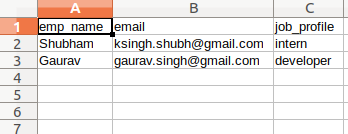
The data.json file in the previous example is a file that contains data in JSON format. If the JSON file has a different structure, you may need to adjust the code accordingly. Please note that this code assumes that the JSON file is an array of objects, each having the same keys. The fieldnames for the writer are set to the keys of the first element of the data. Then, it creates a new CSV file and uses the CSV module’s DictWriter() class to write the data to the file. In this example, the code first opens the JSON file using the open() function and the JSON module’s load() function, which reads the file’s contents and converts it to a Python object. # Create a new CSV file and write the data with open( 'data.csv', 'w', newline = '') as csv_file:

Step 2: Open the CSV file using a file handlerĪ file handler can easily be initiated, there are many ways to do this but we will stick to the safest one i.e.Import csv import json # Open the JSON file with open( 'data.json') as json_file:

Input function can also be used to display some string while asking for input Input function by default takes input in the form of a string and this is exactly what we need. This can be achieved with the help of the input function. Step 1: Take input the CSV file and the JSON file paths We will approach his problem in various small steps so that we understand the problem thoroughly and easily.

It is commonly used for transmitting data in web applications, so whenever there’s a need to send some data from the server to the client, the data is first converted to JSON and then sent to the client so it can be displayed on a web page, or vice versa. JSON is a standard text-based format for representing structured data based on JavaScript object syntax. Why would you want to convert CSV to JSON?

We’ll learn how to use the JSON (JavaScript Object Notation) library of Python and will try to understand the logic behind this conversion. In this article, we will convert CSV to JSON using a simple Python script.


 0 kommentar(er)
0 kommentar(er)
